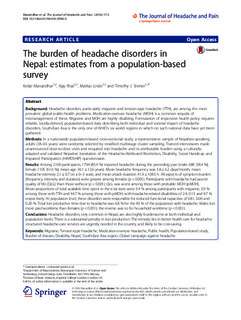| dc.contributor.author | Manandhar, Kedar | |
| dc.contributor.author | Risal, Ajay | |
| dc.contributor.author | Linde, Mattias | |
| dc.contributor.author | Steiner, Timothy J. | |
| dc.date.accessioned | 2019-01-21T09:00:20Z | |
| dc.date.available | 2019-01-21T09:00:20Z | |
| dc.date.created | 2016-02-17T13:22:00Z | |
| dc.date.issued | 2016 | |
| dc.identifier.citation | The Journal of Headache and Pain. 2016, 17:3 . | nb_NO |
| dc.identifier.issn | 1129-2369 | |
| dc.identifier.uri | http://hdl.handle.net/11250/2581394 | |
| dc.description.abstract | Background
Headache disorders, particularly migraine and tension-type headache (TTH), are among the most prevalent global public-health problems. Medication-overuse headache (MOH) is a common sequela of mismanagement of these. Migraine and MOH are highly disabling. Formulation of responsive health policy requires reliable, locally-derived, population-based data describing both individual and societal impact of headache disorders. South-East Asia is the only one of WHO’s six world regions in which no such national data have yet been gathered.
Methods
In a nationwide population-based cross-sectional study, a representative sample of Nepalese-speaking adults (18–65 years) were randomly selected by stratified multistage cluster sampling. Trained interviewers made unannounced door-to-door visits and enquired into headache and its attributable burden using a culturally-adapted and validated Nepalese translation of the Headache-Attributed Restriction, Disability, Social Handicap and Impaired Participation (HARDSHIP) questionnaire.
Results
Among 2100 participants, 1794 (85.4 %) reported headache during the preceding year (male: 689 [38.4 %], female 1105 [61.6 %]; mean age 36.1 ± 12.6 years). Mean headache frequency was 3.8 ± 6.2 days/month, mean headache intensity 2.1 ± 0.7 on a 0–3 scale, and mean attack duration 41.9 ± 108.5 h. All aspects of symptom burden (frequency, intensity and duration) were greater among females (p < 0.001). Participants with headache had poorer quality of life (QoL) than those without (p < 0.001); QoL was worst among those with probable MOH (pMOH).
Mean proportions of total available time spent in the ictal state were 5.4 % among participants with migraine, 3.9 % among those with TTH and 44.7 % among those with pMOH, with headache-related disabilities of 2.4, 0.15 and 9.7 % respectively. At population level, these disorders were responsible for reduced functional capacities of 0.81, 0.06 and 0.20 %. Total lost productive time due to headache was 6.8 % for the 85 % of the population with headache. Males lost more paid worktime than females (p < 0.001); the reverse was so for household worktime (p < 0.001).
Conclusions
Headache disorders, very common in Nepal, are also highly burdensome at both individual and population levels. There is a substantial penalty in lost production. The remedy lies in better health care for headache; structured headache-care services are urgently needed in the country, and likely to be cost-saving. | nb_NO |
| dc.language.iso | eng | nb_NO |
| dc.publisher | BMC (part of Springer Nature) | nb_NO |
| dc.rights | Navngivelse 4.0 Internasjonal | * |
| dc.rights.uri | http://creativecommons.org/licenses/by/4.0/deed.no | * |
| dc.title | The burden of headache disorders in Nepal: estimates from a population-based survey | nb_NO |
| dc.title.alternative | The burden of headache disorders in Nepal: estimates from a population-based survey | nb_NO |
| dc.type | Journal article | nb_NO |
| dc.type | Peer reviewed | nb_NO |
| dc.description.version | publishedVersion | nb_NO |
| dc.source.pagenumber | 10 | nb_NO |
| dc.source.volume | 17:3 | nb_NO |
| dc.source.journal | The Journal of Headache and Pain | nb_NO |
| dc.identifier.doi | 10.1186/s10194-016-0594-0 | |
| dc.identifier.cristin | 1336944 | |
| dc.description.localcode | © 2016 Manandhar et al. Open Access This article is distributed under the terms of the Creative Commons Attribution 4.0 International License (http://creativecommons.org/licenses/by/4.0/) | nb_NO |
| cristin.unitcode | 194,65,30,0 | |
| cristin.unitname | Institutt for nevromedisin og bevegelsesvitenskap | |
| cristin.ispublished | true | |
| cristin.fulltext | original | |
| cristin.qualitycode | 1 | |

